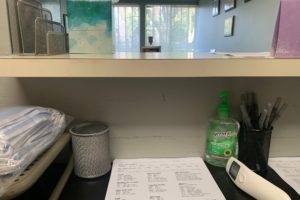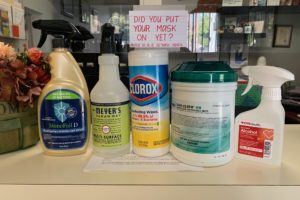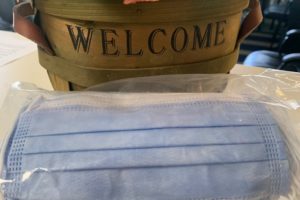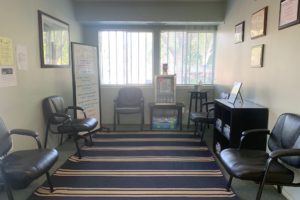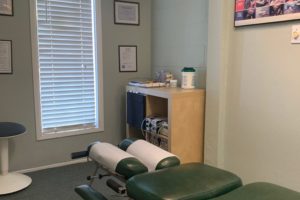Covid 19 Information
Click here for updated information as of 11/1/20 including our Resistance Pack
For the information of our patients and community…
Muldavin Chiropractic is open, and has been open, since the “shelter in place” order was put into place. Chiropractic care was deemed “essential” (by Homeland Security) for remaining open during social-distancing and shelter in place mandates, as a healthcare provider. Over the last several months, we have adapted to the, almost daily, changes in the science and recommendations from the CDC, WHO, John Hopkins, and other state and federal officials [1,2]. In addition, to being available for in-office treatment, we are also capable of doing “telemedicine” appointments on the Doxy.me platform or via telephone for interview/concerns and/or needed at-home treatment protocols. (Please feel free to contact our office for these appointments)
Here at Muldavin Chiropractic, we take the health and safety of our patients very seriously and have put into practice the following steps:
- Masks - all patients and staff (including Dr. Muldavin) are required to wear a mask or other face covering while in the office. This includes any person who may accompany a patient to their appointment. If any person is without a mask, one is provided for them at no charge.
- Hand Washing - every person entering the office is required to thoroughly their hands before being treated. (This protocol also is required of any person accompanying a patient to their appointment) Furthermore, Dr. Muldavin and staff thoroughly wash their hands between patients, as is a regular practice with or without a global pandemic.
- Patient Screening - any patient’s who are not regularly being treated (call-in appointments after 1-2+ months of non-treatment) are given a short questionnaire regarding their COVID-19 exposure (these questions are also asked over the phone when a patient calls in for an appointment), as well as have their temperature taken with a non-contact laser thermometer. Any person who displays any flu-like symptoms (including persisted cough, high fever, severe sore throat, persistent difficulty breathing and/or respiratory illness) and/or has had possible exposure is asked to re-schedule for at least 2-weeks out.
- Office Surfaces/Spaces - all surfaces and spaces are thoroughly cleaned and sanitized (above and beyond standard practices used prior to COVID-19) between patients, as well as doorknobs, chairs, and bookcases. In addition, patients are not currently required to “sign-in” by physically writing their names on a sign-in sheet, this is done for them by front office staff while the patient washes their hands. If the patient needs to use a pen to fill out forms and/or sign a receipt, they are given a sanitized pen to use, which is then immediately put aside in a container for cleaning/sanitization before it is used again. Any clipboards used by patients or staff are also cleaned and sanitized between uses.
- Social Distancing - our waiting room chairs have been reduced and spaced out to allow as much distance for waiting patients as possible. In addition, daily appointments have been reduced somewhat to help avoid any prolonged period of waiting in the front waiting room. Every effort is made to take patients to their treatment rooms immediately after they have washed their hands and been checked in, in the order they are scheduled.
- Therapy Modalities/Area - normally, therapy modalities such as ultra-sound (US) or electric muscle stimulation (EMS) are performed in one central room in our office, however, during COVID-19 we have split up these spaces and only allow patients who share the same household to get US and or EMS at the same time, otherwise only one person is allowed in the therapy room at any given time, and we now have a second room for these therapies for patients to receive ultra-sound and/or EMS, should the therapy room already be occupied.
- Front Desk/Sign-in Desk - the front counter where patient’s check-in for their appointments has a plexiglass barrier to help protect both our staff and our patients.
Customary Practice for COVID-19
As of 06/01/2019, taken from the CDC and WHO [1, 2]:
What is it?
COVID-19 is an infectious disease that was recently discovered - a novel (new) virus that was unknown prior to December 2019.
How Does it Spread?
Information about how COVID-19 is spread has changed over the past several months. At this time, COVID-19 is believed to be spread by close contact person-to-person by way of respiratory droplets. New research indicates that there may be a significant number of people who carry the virus asymptomatically (not showing any symptoms). The moisture in our breath (i.e. respiratory droplets that transmit the virus) travels at least 6-feet when speaking normally, and even further when a person coughs, sneezes, or yells, this is why it is important to 1. Maintain at least a 6-feet social distance, and 2. Wear a mask or other face covering over the nose and mouth.
The newest information coming out of research shows that COVID-19 is spreading more “efficiently” than INFLUENZA (but, thankfully, not as efficiently as the measles which is highly contagious).
It was initially believed that the virus was being spread by people touching surfaces that had traces of the virus on it. While it is still possible that this could occur if a person touches an uncleaned/un-sanitized surface and then immediately touches their nose, mouth, or eyes, it is currently believed to NOT be part of the main mode of transmission. Research is still being done on this topic, therefore it is still important to sanitize hard surfaces that people regularly come into contact with, as well as regularly washing hands (or use hand-sanitizer when thoroughly washing one’s hands is not immediately possible).
Should I Be Wearing Gloves?
In most situations, such as running errands/grocery shopping, wearing gloves is not particularly necessary, since the virus is not contracted through the skin. It is better to forgo gloves and instead wear a mask or other face covering, maintain social distancing, continue washing your hands (or using hand-sanitizer), and avoid touching your face. The issue with wearing gloves is that they tend to give a person a “false sense of security” because the surface of any gloves worn could possibly transmit the virus to you should you touch your eyes, nose, or mouth with a gloved hand that has come in contact with an infected/contaminated surface.
However, gloves are beneficial for those who are working in a healthcare setting/situation, such as caring for a family member in their home or in a hospital. As long as these gloves are removed and disposed of directly after contact with any person they are treating. In addition, it is vitally important that any person using gloves wash their hands thoroughly immediately after removing the gloves.
What Is the Incubation Period and How Long is it?
The “incubation period” (the time between contracting the virus and beginning to show symptoms) for COVID-19, according to most recent research, indicates it is between 1-14 days, with the common average of 5 days. Research is showing that many people may be carrying the virus without symptoms (asymptomatic). Again, this is why it is very important to wear a mask/face covering while out in public. This is not only to protect yourself, but to help protect other people.
What are the Symptoms of COVID-19?
The symptoms of COVID-19 can range from ABSOLUTELY NO SYMTPOMS (as many people can carry the virus without showing any symptoms) to a variety of flu-like symptoms. New research has shown that symptoms of COVID-19 have expanded over the last several months. In most cases, symptoms are continued to be reported of high fever, severe dry cough, sore throat, and exhaustion/tiredness, with some persons reporting basic aches and pains, running nose, or diarrhea. Once a person begins exhibiting shortness of breath/difficulty breathing it is considered an emergency situation and should seek medical attention as soon as possible.
More unusual symptoms are now being reported, such as loss of taste and/or smell, “COVID Toes” which is an inflammation of the blood vessels of the toes. It is now reported that children who contract the virus show symptoms which include: lengthy fevers, low blood pressure, rashes, redness of the eyes, stomach upset, and inflammation of the heart and its arteries. Furthermore, symptoms now share characteristics associated with Toxic Shock Syndrome (TSS) and Kawasaki Disease. This is currently noted in approximately 1-2% of reported COVID-19 cases.
Recommendations (as of 06/01/2020):
- Regularly and thoroughly wash your hands, for at least 20 seconds, making sure to get all surfaces of the hands, including the back of the hands. Use of an alcohol-based hand cleaner/sanitizer is recommended only if clean water and hand soap is not readily available. The mechanical action of washing ones hands not only helps to destroy the fragile structure of the virus, it also aids in removing the virus from the surface of your hands (hand-sanitizers only help to destroy the virus cells, it does not remove it from the surface of your hands).
- Social Distancing is still very important, which is what we have already heard over and over by physicians and scientists who have been studying this virus. Generally, on average, a distance of at least 6-feet should be maintained in all public spaces.
- Masks and/or other face coverings, that cover both the nose and mouth, when in a public space, even if you have no symptoms. It is recommended that all persons should behave as if they have the virus, therefore working to protect others by distancing, washing hands, and covering their nose and mouth when in the presence of people whom to do not share a living space.
The Science of COVID-19
The science behind how COVID-19 “attacks” a person’s body is beginning to be better understood as more research is done and symptoms are reported and tracked by healthcare workers. Therefore, in order to understand the science, we have to remember that our lungs, heart, kidneys are made up of cells and these cells have a protein on their surface, called angiotensin-conversion-enzyme-2 (ACE-2). The COVID-19 virus has a significant affinity towards the ACE-2 surface protein and attaches to them using this attachment as a “gateway” to these cells in the lungs, heart, and kidneys. [3]
Once COVID-19 has been able to enter the cell, the cell sends out proteases, which are enzymes, to try to breakdown and destroy the virus. This unfortunately allows COVID-19 to “fuse” with the host cell and deposit its RNA (genetic material) into the cell and replicate itself. This is not unlike a computer virus. This process destroys the host cells and distributes thousands of particles of the virus which then infect other cells, in particular cells along the respiratory tract. On occasion, our immune system’s response to infection causes “collateral damage” to our body with an exaggerated response which can cause additional problems, outside of the original infection.
Moreover, this heightened response creates immune cells called ‘cytokines’ to help coordinate the fight against the virus. However, if the immune system is not healthy this exaggerated response causes a “cytokine storm” which leads to the severe difficulty breathing and death in those with severely compromised immune systems. This is when a person has to be put on a ventilator in a hospital and unfortunately only approximately 25% of people put on a ventilator will survive, at this time. Consequently, the 2 most common steps taken to stop the COVID-19 virus is to either stop the binding of the virus to host cells and/or stop the replication of the RNA of COVID-19 within the cells and prevent the “cytokine storm.” [4]
Lifestyle Strategies and Tips to Boost Immunity
At the ends of the day, COVID-19 is a virus that attacks the cells in our bodies and those with sensitive and/or compromised immune systems are more at risk of infection which can lead to significant complications and even death. Therefore, it is important to try and support/improve your immune system which can possibly help prevent contracting COVID-19 and recovering from this disease.
The research shows that COVID-19 affects seniors and those with compromised immune systems/significant comorbidities (such as cancer, high blood pressure, diabetes, and obesity - which leads to a more severe immune response and the “cytokine storm,” as mentioned above,) more so than younger and/or healthier people.
There are some young people and children that have contracted COVID-19, some with serious cases that have resulted in serious side-effects and even death, however this has been shown to be rare.
At this time, these are some recommendations/topics that Dr. Muldavin would be more than willing to discuss in depth with any patient and you are welcome to call the office should you wish to do so. These are important considerations we should all be taking to help protect ourselves (and in effect, others) from COVID-19:
11/1/2020 Update
- Is there a link between Blood Type and a propensity to COVID-19? -
Recent research says “YES.” Several studies indicate that Blood Type A may be more susceptible to contracting the disease and those with Type O may possess protective heredity that puts them at a lower risk. Research done in March 2020, from the Wuhan University in China, showed that those with Type A not only showed a higher rate of infection but also developed more severe symptoms.
Furthermore, German researchers at the University of Kiel found similar findings. They found that patients with Blood Type A were 50% more likely to need oxygen support or ventilators than those with other blood types. Also, in April 2020, company 23 and Me launched a study which was published in ‘Bloomberg News’ that found “Preliminary results from more than 750,000 participants suggests that Type O blood is especially protective against SARS-COVID-2. The Wuhan University and University of Kiel research studies corroborate that Type O blood was linked to lower instances of severe illness.
Additionally, the Associate Editor of ‘MedPage Today’, Molly Walker, on 10/14/2020 finds more evidence pointing to Blood Type and COVID19. In Denmark, Blood Type O was associated with reduced risk of developing COVID19 and Types A, AB, and B are at higher risk for thrombosis and cardiovascular disease. Furthermore, a small study in ‘Blood Advances’ found Type A and/or AB in COVID-19 patients was associated with increased risk for mechanical ventilation, renal replacement therapy, and prolonged ICU admission, versus those with Type B or O.
Dr. D’Adamo, who is the pioneer for blood type research, predicted that Type A’s would have a predilection or propensity toward more infections than Types O and B. This was prior to research that has occurred recently and corroborated his theory.
For the person reading this, I believe it is important for one to understand what their blood type is and potential resistance or propensity towards disease, in particular COVID19 at this time.
Another interesting study (from John Hopkins University) which has come out shows that Japan has an almost non-existent COVID-19 death per million residents. Whereas the United States has the highest COVID-19 deaths per million residents, and this number is still climbing. In my opinion, there are 2 main reasons why the COVID death per million residents is almost non-existent in Japan whereas in the United States it is extremely high. The first reason is that Japan is a “Collectivist Society” where they believe in the group and conform/comport to public health edicts, whereas the United States is very individually oriented. The second reason, and maybe more important reason, is that overall Japan is a much healthier country than the United States. The obesity rate is very low in Japan, and their diet is much healthier overall. The United States has significant rates of obesity, and our diet/health and immune systems pay the price for this. Research has shown that obesity is another significant risk factor in contracting COVID-19 and obesity leads to higher mortality rates.
Recommendations for Staying Healthy & Improving Immunity (as of 10/26/2020)
- Look at recommendations on this website, listed as of 06/01/2020 - as listed, it is more important than ever to get 6-8 hours of sleep and drink up to 64 oz. of water per day. Decreasing stress is very important as increased stress releases hormones which can lower immunity. Proper nutrition is very important and should include leafy greens and hearty high fiber vegetables. Other foods such as turmeric, Greek yogurt, garlic, curry, walnuts, and almonds have all been shown to be very beneficial to our overall health.
- Supplements - Research has shown that Melatonin is beneficial to blocking COVID attachment sites from the ACE2 receptors of our cells. If there are not any contra-indications, I would recommend 3mg taken at night (please see the ‘Science of COVID-19’ on this website).
Additionally, I would highly recommend the four supplements in the ‘Resistance Pack’ developed by Dr. D’Adamo, who is the developer and leader in Blood Type based diets and health.
The ‘Resistance Pack’ is formulated to reflect the new research pertaining to the respiratory, metabolic, circulatory, and digestive challenges (as a result of COVID19 and Influenza) to our immune systems likely to be challenged in the Fall of 2020 through the Winter of 2021. This combination of Elderberry, Quercetin, Andrographis paniculata, Chinese Skullcap Root, and Vitamin D are very helpful to improve the immune system in this challenging time. If you are interested in obtaining this ‘Resistance Pack’, it is available from our office for $99.00 - call our office and we can order the pack directly from D’Adamo which will save you the shipping price. This pack for $99.00 is at least one-month worth of the supplements.
- Dr. Muldavin also recommends regular Chiropractic adjustments, as research now shows the connection of the brain, immunity and Chiropractic adjustments. A study performed at the University of Madrid Medical School found that with manipulation certain beneficial neuropeptides increased. The specific neurotransmitters are called Cortisol and they found that after 2 hours post-manipulation, an increase was found only in the cervical spine adjusted group when compared with pre-intervention levels. They found the cervical spinal manipulation group showed a significant increase in cortisol plasma concentration immediately post-intervention, compared with base values. This verifies that Chiropractic care has a direct effect on the cortisol immunity connection through the neuroendocrine reaction. [link 1 - Marzano Ortega et al, Changes in Biochemical Markers of Pain Perception and Pain Response After Spinal Manipulation, in Journal of Orthopedic and Sports Physical Therapy 231-239]
- It is more important than ever to get at least 7-8 hours of sleep per night. Being properly rested is vitally important to our health.
- Drink plenty of water per day, up to at least 64 ounces per day.
- Decrease daily stress as much as possible. Getting proper sleep is an important part of this, as well as utilizing stress reducing practices such as meditation and exercise.
- Proper nutrition is also very important to maintaining a healthy body, especially in times of a global pandemic. Eating beneficial foods such as leafy green vegetables and hearty high-fiber vegetables like broccoli, kale, cabbage, and spinach. Other foods like those including turmeric, Greek yogurt, curry, garlic, walnuts, and almonds have also shown to be very beneficial to our overall health.
- Melatonin - most commonly used as a sleep aid, has been shown to be beneficial in blocking the attachment site of COVID-19 to the ACE-2 receptors of our cells (as describes above). Studies has shown that as we age melatonin that naturally occurs in our body decreases and researchers are starting to understand why this may contribute to the severity in which COVID-19 affects senior citizens. Melatonin supplements are in general helpful to aid sleep, reduce stress, and even ease bowel movements. Outside of those with a history of gastrointestinal/digestive issues, it would not be a bad idea to take some melatonin regularly to possibly help prevent the biding of the virus to the ACE-2 receptor cells. If you have questions, please feel free to contact our office to speak with Dr. Muldavin about this in more detail. [5,6]
- Elderberry - elderberry supplements have been shown to be beneficial and have “anti-viral” properties which can boost the immune system against viruses. While it has not been directly studied with regards to COVID-19, this will be part of my “two-pronged” strategy coming in the fall, which is when experts have indicated will be the “second wave” of COVID-19 case increases. [7]
- Chiropractic Adjustments - chiropractic adjustments, especially to the cervical and thoracic spine (neck and upper back), have been shown to increase the immune system for up to 8 hours following and adjustment.
Please contact our office and keep up with our website for more information on supplements and additional information in the fall.
Sources:
- Guidance Documents/CDC - www.cdc.gov/coronavirus/2019-NCOV/communication/guideance-list.html
- www.who.int/emergencies/diseases/novel-coronavirus-2019/advice-for-public
- ACE2; How Researchers Think Coronavirus Attacks Cells and How it Could be Stopped - Cleveland.com, May 24th, 2020, Emily Bam Fortis
- COVID-19 - A New Virus, but a Familiar Receptor and Cytokine Release Syndrome; Immunity, May 19th, 2020, pg 731-733, Hirano Murakami
- COVID-19, Pneumonia & Inflammasomes - The Melatonin Connection, Evolutamente; March 14th, 2020, Doris Loh, pg 1-38
- Adequate Melatonin Reduces Infectiousness of COVID-19; A Simple Guide, Deep Roots at Home, March 19th, 2020 - online
- Elderberry and the Influenza Virus; Nature Heals; October 28th, 2019, Camille Corso, pg 1-7
